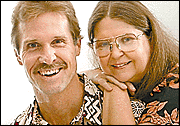Advertisement - Click to support our sponsors.


Health Options
ON June 26, researchers from the international Human Genome Project announced they had completed the first genetic mapping of a human being. Although this is considered a rough map of approximately 80,000 to 100,000 genes, it is the discovery of the decade. Genetic mapping
holds hopeIn practical terms, we now have a very long, very complex coded message, a "recipe" for a human. However, we have yet to decipher this message.
It's like knowing that you possess the recipe for a cake written in some galactic language. You just have to translate the information to figure out the ingredients and their amounts.
This translation is the next big step in research. The ramifications will be rather amazing, leading to completely new ways to prevent, diagnose, treat and cure disease.
The genome "map" is essentially a list of the sequence of four compounds that form the basic structure of DNA in the human chromosome.
These compounds are adenine (A), thymine (T), guanine (G) and cytosine (C). A section of a single DNA strand reads something like ACGCCTACG with the letters representing one of the four compounds that make up the DNA strands. The order in which the compounds appear on a section of DNA will determine the exact structure of a particular protein made in the cell. DNA is simply the body's instructions for making thousands of different proteins.
The proteins that are made in a cell determine its destiny. Some proteins provide structure. Others serve as hormones that provide chemical messages, antibodies that disable foreign invaders or enzymes that speed up essential chemical reactions. If the DNA code is off the usual sequence by just one letter for just one important protein, the effects can be profound and devastating to a person's health. The seriousness of the defect or divergence from the usual pattern depends on the function of the particular protein and how much the change disables its function. It's even possible that a divergence could have positive effects.
SOME of the information in DNA can affect how much of a protein like a hormone is produced. If too much or too little is made in the cell, there are associated health problems. For example, if a woman produces too much estrogen over a lifetime due to a genetic variation, she increases her risk of breast cancer. If she knows that she has this characteristic early in life, she could take measures in her lifestyle and diet that could minimize this risk.
Such knowledge could also help patients and doctors weigh the risks and benefits of different treatments for a given disease. For example, a type of chemotherapy that would work well for one person with a particular DNA sequence might be inappropriate for someone with a different DNA sequence.
At present, most medical practice is based on diagnosing and fixing parts of the body in need of repair. However, if individuals know their genetic weaknesses from birth, it will be more appropriate for medicine to focus on preventing those weaknesses from being realized. New medicines will definitely be developed, but individuals will also know how to change their eating patterns to minimize their disease risk.
Even now you can lower your risks for heart disease and cancer by eating more fruits and vegetables and consuming less total fat. Start your own preventive medicine program now.
Health Events
Joannie Dobbs, Ph.D., C.N.S., is a food and nutrition consultant
and owner of Exploring New Concepts, a nutritional consulting firm.
She is also responsible for the nutritional analyses
indicated by an asterisk in this section.Alan Titchenal, Ph.D., C.N.S., is a sports nutritionist in the
Department of Human Nutrition, Food and Animal Science,
University of Hawaii-Manoa.